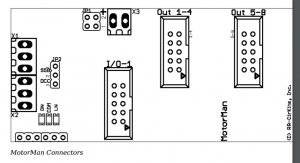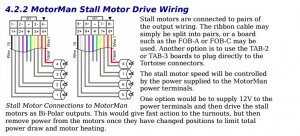Thanks for taking the time and explaining things, I understood everything.... I hope...wow
BUT, just to make sure.
By getting the LocoBuffer USB device and the SSB GateWay, the computer can talk to my NCE system.
I need to install a MotorMan device for every tortoises (turnouts) I have and need to install now (better than later) and my push buttons can manually work (until computer system is ready)
If It's all ok, now I need to know how to connect everything. I check their site and some components, but there's no wiring diagram.
Thanks again
Hi Lloyd,
The LocoBuffer USB and SSB Gateway are needed so the computer (and thus Train Controller) can communicate with the RR-CirKits devices.
Your NCE Power Pro 5 system already has a serial port built-in. To connect this NCE system to the computer you will need a USB-to-Serial converter. There are many out there and some work better than others.
I have always used these and have never had a problem:
http://www.tripplite.com/keyspan-high-speed-usb-to-serial-adapter-microsoft-surface~USA19HS/
As to the MotorMan...
Each MotorMan will control eight Tortoise units.
I'm getting ready to run errands so I will be off-line for awhile.
When I get back I will make up a set of instructions and diagrams.
RR-CirKits can provide the wiring you needed or you can make up your own.
For now see the attached.
In the drawing of the MotorMan board (which is about 1.5" by 3.5" in size) you can see the three rectangular connectors with the 10 round pins each.
They are labeled "I/O-1", "Out 1-4" and "Out 5-8".
The "I/O-1" connector is for your push buttons.
The "Out 1-4" connector is for the first four Tortoise devices to be controlled by this one board.
The "Out 5-8" connector is for the next four Tortoise devices to be controlled by this one board.
The two small connectors on the left, drawn as two sets of three black ovals with circles in the center, are for the Simple Serial Bus SSB connections (3 screw terminals each).
The SSB is only three conductors but the board provides two places to connect a SSB "cable", so you can easily connect one board to another.
You can, if it makes things easier to understand, think of one of the 3 terminal connectors as being the SSB "IN" connector and the other as being the SSB "OUT" connector.
You can buy 3 conductor cable OR you can make up your own cable by using individual wires and twist them together using an electric drill - something I've done a lot of.
The last connector at the middle, top is a two position screw terminal connector (labeled X3) which is for the DC power connection to power the Tortoise devices.
This power is supplied using it's own connector as folks have there own preference as to how fast they want their Tortoise units to move.
You can supply DC power from 5 to 25 volts, the greater the voltage the faster the Tortoise move. I found that 14 volts suited me.
There are numerous sources of low cost DC power supplies in this range and one power supply can provide Tortoise power for the whole layout.
Got to go now but will be back.
Frederick



